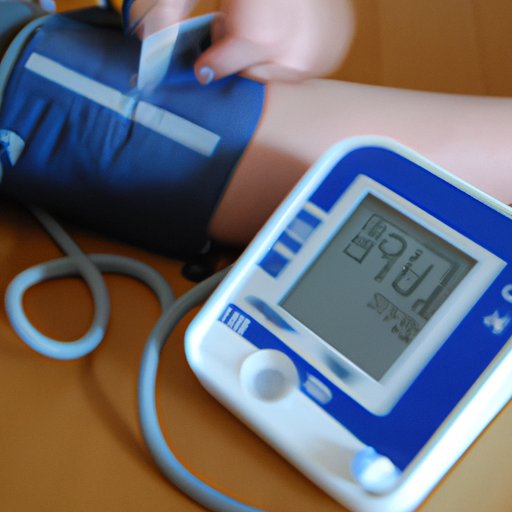I. Introduction
Measuring blood pressure is an essential aspect of monitoring one’s health and well-being. High blood pressure, or hypertension, is a common health issue that can lead to serious health problems when left untreated. By regularly measuring blood pressure at home, individuals can detect any changes in their readings and take preventative measures to ensure optimal health. In this article, we will provide a comprehensive guide on how to measure blood pressure at home, including the different types of monitors available, how to interpret readings, and more.
II. Types of Blood Pressure Monitors
There are different types of blood pressure monitors available for home use, including wrist, upper arm, and finger monitors. Wrist monitors are convenient and portable, while upper arm monitors are more accurate and reliable. Finger monitors are the least accurate and should only be used for tracking trends, not for diagnosing hypertension.
When selecting a monitor, consider your individual needs and preferences, as well as any underlying health conditions that may affect the choice of monitor. Consult with a healthcare provider if you have any questions or concerns about which monitor is right for you.
Once you have selected the appropriate monitor, it is essential to follow the manufacturer’s instructions carefully for accurate readings. Generally, you should sit comfortably with your feet flat on the floor, rest your arm at heart level, and avoid talking during the reading.
III. Importance of Regular Blood Pressure Monitoring
Regularly measuring blood pressure is crucial for detecting hypertension and other health issues. Hypertension is often called the “silent killer” because there are often no symptoms until it reaches a severe stage, such as a heart attack or stroke. By monitoring blood pressure at home, individuals can detect any changes early and take preventive measures.
Early detection and management of hypertension can reduce the risk of serious health problems and improve overall health and well-being. Many individuals have experienced the benefits of regular monitoring and have successfully managed their blood pressure with simple lifestyle changes, such as a healthy diet, regular exercise, and stress management techniques.
IV. Preparing for a Blood Pressure Reading
Preparation is essential when taking a blood pressure reading, as certain factors can affect readings. Avoiding caffeine before taking readings, going to the bathroom, and resting for a few minutes before the reading can help reduce the risk of inaccurate readings.
It is also important to take readings at the same time each day for consistency and to account for any factors that may influence readings, such as stress or physical activity.
V. Factors that Influence Blood Pressure Readings
Several factors can influence blood pressure readings, such as age, gender, time of day, and stress. Older individuals and women tend to have lower blood pressure readings than younger individuals and men. Blood pressure can also fluctuate throughout the day, peaking during periods of stress or activity.
To get accurate readings, account for these factors, and regularly monitor blood pressure at the same time each day. Keep track of readings and any factors that may have influenced them to maintain consistency.
VI. Interpreting Blood Pressure Readings
Interpreting blood pressure readings is crucial for understanding one’s health status. Blood pressure readings consist of two numbers, the systolic and diastolic pressures. The systolic pressure represents the highest pressure when the heart contracts and pumps blood, while the diastolic pressure represents the lowest pressure when the heart is at rest between beats.
A blood pressure reading below 120/80 mmHg is considered normal, while a reading of 120-139/80-89 mmHg is considered prehypertensive. A reading above 140/90 mmHg is considered hypertensive and requires medical attention.
High blood pressure can lead to serious health problems, such as heart disease and stroke. If blood pressure consistently falls outside of a healthy range, seek medical attention immediately.
VII. Conclusion
Measuring blood pressure at home is a simple yet effective way to monitor one’s health and prevent serious health problems. By selecting the appropriate type of monitor, preparing for readings, accounting for factors that influence readings, and interpreting readings properly, individuals can maintain optimal health and well-being. Consult with a healthcare provider if you have any questions or concerns about measuring blood pressure at home.
